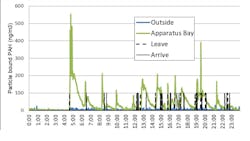Are Fire Stations Contributing to Cancer Risk?
Firefighters spend significant portions of their shifts in the station,5 during which time they may be exposed to pollutants such as diesel exhaust from idling apparatuses6–7 and off-gassing and particle re-suspension from contaminated post-fire gear.8 Studies in other industries have demonstrated the link between poor air quality (e.g., exhaust) and several health outcomes, including cancer,6–7, 9–10 yet this has not been examined in detail among firefighters.
Research partnership with BFD
In 2015, our research team at Dana-Farber Cancer Institute and Harvard T.H. Chan School of Public Health formed a partnership with the Boston Fire Department (BFD) and the Local 718 Firefighters Union to examine air quality at fire stations. To start, we conducted a study that has provided preliminary data on air quality within four fire stations in and around Boston, and has investigated some factors that may be influencing levels of contaminants in indoor air.
We focused on exposures at the fire station for two reasons. First, few scientific studies have examined the fire station work environment, and those that had were either several decades old, tested air quality for only a few hours, or used information from interviews only. Second, compared with some exposures encountered during firefighting, exposures at the fire station may be more easily modified through changes in how things are done; therefore, we aimed to identify policies and practices that could be targeted in future interventions.
Air sampling and officer interviews
The study, which involved air sampling and interviews, took place in the spring of 2016. We collected data from four stations: Stations 1, 2 and 3 (each containing one ladder and one engine company, built between 1948 and 1974), located in Boston, and Station #4 (containing one engine company, built in 2007), located in a suburb of Boston.
The air sampling involved collection of particulate matter (PM2.5) and measurements of particle-bound polycyclic hydrocarbons (PAHs). We chose to measure these contaminants because they represented good proxies for diesel exhaust and other potential exposures from station-related activities (e.g., re-suspension of particulates from gear or cooking).
We sampled in the apparatus bay, kitchen and outside the station. This allowed us to investigate relative differences between stations, as well as between multiple locations within a station. We wanted to compare the outside and inside measurements to identify potential indoor particle sources, or determine if the observed levels were the result of outside activity, such as nearby highways. At each station, we collected samples continuously for 5–7 days. For more detailed information on our methods, see the full article in the Journal of Occupational and Environmental Medicine (https://tinyurl.com/JOEM-ff).11
We also conducted a series of officer interviews at each of the stations. The goal was to learn about the daily activities of firefighters, as well as the written BFD policies and unofficial station practices regarding apparatus idle-time, cleaning of contaminated gear, and other station-related health and safety activities.
Particulates found in apparatus bay
All stations had similar ventilation systems—flexible ducts that attach directly to the apparatus and transmit exhaust out of the bay (see Figure 2). These systems, which are common in fire stations, require a firefighter to attach the duct to the apparatus, either as it backs in, or after it has backed in and the engine is turned off. In both cases, one or more firefighters may be exposed to exhaust: the firefighter who attaches the duct as the apparatus backs in may encounter direct exposure and, by backing the apparatus in uncovered, the exhaust may be emitted for longer and the entire station may encounter exposures.
Station design
We compared the levels of particulates in the kitchen to those outside. While levels in the kitchen did rise and fall periodically, the changes were not statistically significant from those outside. Interestingly, the particulate levels in the kitchen of Station 4, the newest station, were almost six times lower than that of the older Boston stations despite the fact that the particulate levels in the apparatus bay of Station 4 were almost three times higher than the Boston stations. While this was unexpected, it highlighted the impact of building design and layout on air quality. Station 4 was designed with an effective separation between the apparatus bay and living quarters, with doors remaining shut at all times. Consequently, even though contaminant levels were high in the apparatus bay, the particulates were restricted from transferring into the living quarters. Additionally, it is a single-floor station, so there are no pole holes (which allow air to flow from one area to another if not properly closed between uses) connecting the various zones of the station.
Equipment to wash gear
As mentioned previously, particle re-suspension from smoke-exposed equipment may be another indoor source of particulates. We observed differences in gear-washing practices by station, which was mostly attributed to differences in physical equipment. Two of our stations (1 and 3) had on-site commercial-grade washing machines, whereas the others did not. At the stations without washers, firefighters reported rarely washing gear, maybe once per year. To wash their gear, they had to send it to headquarters (reported to be a slow process); consequently, they frequently would not send their gear in at all. In contrast, in the stations with washing machines, firefighters reported frequent use of the machines (generally after every major fire), along with changes in the practices of washing other equipment not directly cleaned in the washing machines (e.g., boots, facepieces, truck seats). The installation of the washing machines appeared to not only impact cleaning of gear in the machines, but also improved awareness and practices related to equipment cleaning.
Conclusions
While firefighters have an increased risk of developing certain kinds of cancers, many questions remain about the exposure-outcome relationship. One area that has not been thoroughly examined is the contribution of carcinogens at the fire station. This study is one of the first research projects to do so, and represents a critical step in a larger effort to investigate the impact of low level but chronic exposures at the fire station on cancer risk.
This study demonstrated that concentrations of particulates were higher in the apparatus bay, when compared to outside, indicating that there is likely an indoor source, perhaps diesel exhaust or particle re-suspension of fire exposure gear and equipment. Additionally, Station 4 had the highest level of particulates in the apparatus bay, yet by far the lowest in the kitchen. This station, built more recently, demonstrated good separation between areas, achieved through architectural design and selection of building materials.
We also learned that firefighters in stations with commercial-grade washing machines cleaned their smoke exposed gear much more frequently, compared to firefighters in stations without the machines. This carried over to equipment that could not go in the machines, demonstrating improved awareness and cleaning practices. This is an example of the potential change that can result from a small modification in infrastructure.
Future research
Low-level chronic exposure to particulates may contribute to firefighter cancer risk. As this was a small study, there are several important limitations: The study involved only four stations, examined levels of particulates only, and sampling was collected in a narrow range of weather conditions. Our future research will attempt to expand the sampling to fully understand the impact of fire station exposures and the variability and range of values found, with the goal of identifying opportunities to modify policies and practices that may improve firefighter cancer prevention efforts.
This study would not have been possible without our strong partnership with the members of the BFD, who provided valuable guidance and access to the fire stations, which enabled the success of our research, and will set the stage for future work on firefighter cancer prevention.
References
1. Daniels RD, Kubale TL, Yiin JH, Dahm MM, Hales TR, Baris D, et al. Mortality and cancer incidence in a pooled cohort of US firefighters from San Francisco, Chicago and Philadelphia (1950–2009). Occupational and Environmental Medicine 2014;71(6):388-397.
2. Pukkala E, Martinsen JI, Weiderpass E, Kjaerheim K, Lynge E, Tryggvadottir L, et al. Cancer incidence among firefighters: 45 years of follow-up in five Nordic countries. Occupational and Environmental Medicine 2014;71(6):398-404.
3. Tsai RJ, Luckhaupt SE, Schumacher P, Cress RD, Deapen DM, Calvert GM. Risk of cancer among firefighters in California, 1988–2007. American Journal of Industrial Medicine 2015;58(7):715-729.
4. Kang D, Davis LK, Hunt P, Kriebel D. Cancer incidence among male Massachusetts firefighters, 1987–2003. American journal of industrial medicine 2008;51(5):329-335.
5. Kales SN, Soteriades ES, Christophi CA, Christiani DC. Emergency duties and deaths from heart disease among firefighters in the United States. New England Journal of Medicine 2007;356(12):1207-1215.
6. Pronk A, Coble J, Stewart PA. Occupational exposure to diesel engine exhaust: A literature review. J Expos Sci Environ Epidemiol 2009;19(5):443-457.
7. IARC. Diesel engine exhaust carcinogenic; 2012. Vol 105.
8. Fent KW, Evans DE, Booher D, Pleil JD, Stiegel MA, Horn GP, et al. Volatile Organic Compounds Off-gassing from Firefighters’ Personal Protective Equipment Ensembles after Use. Journal of Occupational and Environmental Hygiene 2015;12(6):404-414.
9. Reed MD, Gigliotti AP, McDonald JD, Seagrave JC, Seilkop SK, Mauderly JL. Health Effects of Subchronic Exposure to Environmental Levels of Diesel Exhaust. Inhalation Toxicology 2004;16(4):177-193.
10. Pun VC, Kazemiparkouhi F, Manjourides J, Suh HH. Long-Term PM2. 5 Exposures and Respiratory, Cancer and Cardiovascular Mortality in American Older Adults. American Journal of Epidemiology 2017.
11. Sparer EH, Prendergast DP, Apell JN, Bartzak MR, Wagner GR, Adamkiewicz G, et al. Assessment of Ambient Exposures Firefighters Encounter While at the Fire Station: An Exploratory Study. Journal of Occupational and Environmental Medicine 2017;59(10):1017-1023.

Emily Sparer
Emily Sparer is a research associate at the Center for Climate, Health, and the Global Environment at the Harvard T.H. Chan School of Public Health. Her research focuses on the relationship between environmental factors and occupational health outcomes in the fire service, as well as in the construction and healthcare industries. She holds a bachelor's degree in environmental science from Barnard College, a master's degree in occupational hygiene from Harvard, and a doctoral degree in ergonomics and safety, also from Harvard. Most recently, she completed a post-doctoral fellowship in cancer prevention in a joint program between the Dana-Farber Cancer Institute and the Harvard T.H. Chan School of Public Health.

Lisa Burke
Lisa Burke is a director of Research & Outreach Initiatives at the Harvard T.H. Chan School of Public Health Center for Work, Health, & Well-being, within the Center for Community Based Research at the Dana-Farber Cancer Institute. Her research focuses on organizational change resulting from the study of work environment policies and practices. Her previous experience includes managing multi-site organizational change initiatives and research projects. She holds a bachelor’s degree in political economy from Williams College and a master’s degree in education from the University of Pennsylvania.








